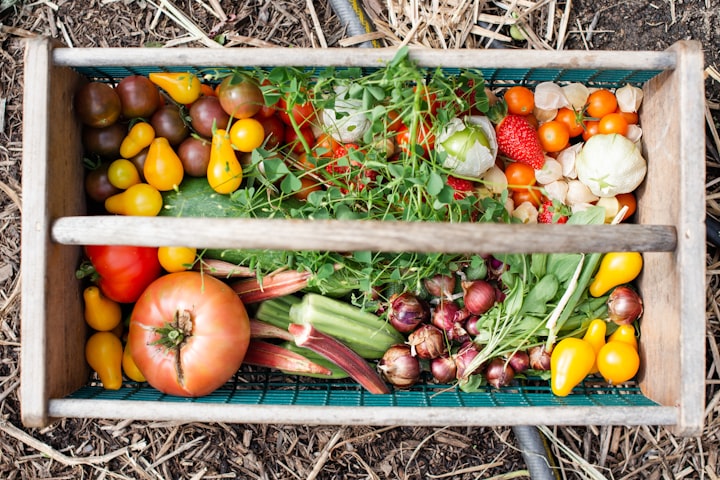How to Start a Vegetable Garden
At Home in 6 Easy + Fun Steps

You’re wondering how to start a vegetable garden. Maybe your neighbor has one. They know where their food comes from and probably save on their grocery bill.
Maybe you want that sense of accomplishment, too.
When you talk to your neighbor about it, they go on and on about how hard, time-consuming, and expensive it is to enjoy their own fresh, nutrient-rich vegetables.
But that neighbor is keeping a secret from you.
Plants know how to grow themselves. They do all the real work and only need a little help from you.
It’s kind of miraculous.
In this guide, we’ll give you step-by-step instructions for the essentials of starting a vegetable garden at home: selecting the best vegetables for you, preparing your soil, planting, and when to harvest.
It’s time to dig in!

Step 1: Find the Best Place to Grow Your Garden
You want to pick a spot for your home vegetable garden that has room to grow, gets enough sunlight, and isn’t too far from water.
If you’re new to vegetable gardening, it’s a good idea to start with a small plot. You don’t want to be overwhelmed by the demands of hundreds of plants before you understand how much time you’ll be able to spend and how much space they’ll take up.
It’s easy to expand a garden later, when it’s already thriving.
Expert tip: If you live in an apartment, try gardening in pots or containers. This way, you can move them to get more or less sunlight and to adjust to the needs of your limited space. Again, start small and transplant to bigger containers as your vegetables develop.
Most vegetables need about six hours of sunlight per day. Then again, certain vegetables, such as lettuce and spinach, have delicate leaves that can burn up. Your best bet is to find a spot open to the sun’s rays, but partially shaded by a tree or ramada during the hottest parts of the day.
Choose a location that’s close to a water source, which in most cases, is a hose or a sprinkler system. If your garden is too far away from water, the extra burden on you could be deadly to your plants.
If you can, check the pH levels of the soil in your chosen spot. If the soil is too sandy or loamy for vegetables, you may need to amend it with compost (see Step 3).

Step 2: Choose the Best Vegetables for You
Once you have your garden plot picked out, you might be tempted to go crazy buying seeds. But there are a few important factors to consider before you start planting.
To begin with, each type of vegetable thrives under different climate and seasonal conditions. For example, cool-weather crops like lettuce and spinach grow best in spring or fall, while warm-weather crops like tomatoes and peppers like to bask in the heat of summer.
Maybe the most important thing to keep in mind is that there’s no point in growing vegetables no one in your house will eat. You can’t show off for your neighbor with the kids making gross faces behind you.
Make a list of your favorite vegetables. Extra points if you find out they grow well in your area.
Once you’ve narrowed down your list, investigate each vegetable’s requirements. Some plants, like cucumbers and tomatoes, require trellising or other support to grow properly. Others, like carrots and radishes, prefer loose soil to grow in.
Each plant’s unique needs will help you decide if it’s a good fit for your garden.
Lastly, make a plan for staggering your planting times so you can harvest many types of vegetables throughout the growing season, rather than all at once. This is called succession planting.
For example, you might plant lettuce. Once it’s been harvested and the bed is empty, you could start your favorite kind of bean. After the beans have had their turn, tomatoes would take their place.
This way, you get a continuous supply of different fresh vegetables, and there will never be a dull moment throughout the growing season.

Step 3: Prepare the Soil for Your Garden
Before you get your hands dirty, know what you’re sticking them into.
Expert tip: If you’re starting your garden in pots with soil you’ve purchased from the garden center, you can skip this step.
If you have a local extension office, ask them to do a soil test to determine your soil’s characteristics.
If you’re on your own and want to get started quickly, follow these steps:
1. Remove any rocks and weeds from the area where you plan to plant.
Weeds siphon nutrients from your plants and compete with them for water and sunlight. Pulling up weeds gives your vegetables a massive favor they’ll reward you for.
2. Improve soil quality with compost or other amendments.
Adding organic matter to your soil supports its structure, fertility, and capacity for water.
Compost adds both nutrients and beneficial microbes to the soil. Other amendments, such as aged manure or leaf mold, can also be used to beef up soil quality.
3. Till the soil to loosen and aerate it.
Tilling breaks up the soil, making it easier for roots to work their way through. This step is especially important if your soil is compacted or heavy.
Be careful not to over-till, since it damages soil structure and harms beneficial microorganisms.

Step 4: Plant Your Vegetable Garden
The actual planting is probably what you imagine when you think about starting a vegetable garden from scratch.
It also drums up the most sense of wonder. You stick something in the ground, and a little while later, a beautiful living thing pops up!
Seeds are the cheapest way to go, but if your first seeds don’t germinate, you risk disappointment that could make you scrap the whole idea.
Plants that have already sprouted are more expensive, but just as easy to find. They’re the safer bet for a beginner gardener who wants fast results.
Both seeds and sprouted plants include planting instructions. Read the seed packet or plant label. You’ll find different requirements for planting depth, spacing, and timing for each type of vegetable.
For example, tomatoes should be planted deeply, with only the top few leaves above ground, while lettuce seeds should be sown on the soil surface.
Space out your plants to give them room to grow and access to nutrients and sunlight.
Enhance your garden with companion planting. Sow a couple of different varieties known to benefit each other close together. For example, growing lettuce with radishes helps to deter pests and maximize your use of space.
Follow these steps for a professional planting technique:
- Make sure the soil is damp, not soggy
- Dig a hole of about the depth and size of the plant
- Place the seed or transplant into the soil gently
- Pack the soil around the plant a little to stabilize it
- Water thoroughly

Step 5: Maintain Your Garden
While the plants know what to do from here, a vegetable garden isn’t exactly a set-it-and-forget-it project. To give your vegetables the best chance to thrive and produce a bountiful harvest, some basic care will go a long way.
Water your plants regularly and deeply, especially during hot, dry weather. Water at the base of the plant to avoid wetting the leaves, which can increase the risk of fungal diseases.
If you have access to an irrigation system, it makes watering easier and more efficient. But you may come to value spending time in your garden, and your plants might enjoy your company, too.
Fertilizing your plants will help them grow strong and productive. If you want this boost, choose a fertilizer appropriate for your plants and follow the instructions carefully.
Too much fertilizer can damage your plants, while too little can lead to stunted growth. An organic fertilizer such as compost feeds your plants and also improves the quality of your soil.
Mulching helps conserve moisture, maintain temperature, and discourage weeds in your soil. Spread a layer of organic mulch such as grass clippings if you have a lawn, fallen autumn leaves, or straw over the surface of your garden.
Make sure not to place the mulch too close to the stems of your plants, as it increases the risk of rot and disease.
Some gardeners swear by newspaper mulching. Newspapers can be easier to obtain than other organic mulches, and they can be placed near the stems with less risk of decay.
Catch pests and diseases before they take over. Signs include holes in leaves, wilting, and discoloration.
Natural methods of pest control, such as companion planting (see Step 4), handpicking pests, or insecticidal soap, are healthier for you and your vegetables.
If you do need to use a pesticide, choose one suitable for your plants and apply it with extreme caution.

Step 6: Harvest Your Vegetables
Congratulations! You’ve successfully grown your own vegetable garden. Now it’s time to harvest and enjoy the fruits of your labor.
Different vegetables let you know when they’re ready to be harvested in different ways.
For example, tomatoes should be a vibrant color and firm to the touch, while lettuce should be harvested when the leaves are mature but before they become too bitter.
Check your plants regularly so you can harvest at the peak of freshness. Harvesting your vegetables at the right time ensures maximum flavor and nutrition.
Don’t wait too long, or the vegetables will become overripe and lose their quality. Here’s where you’ll be grateful to cut out the middleman!
Expert tip: Use sharp shears to avoid tearing the plant.
After harvesting, store your vegetables properly to ensure they stay fresh as long as possible. Some vegetables, like tomatoes, should be stored at room temperature, while others, like lettuce, should be stored in the refrigerator.
Expert tip: If you freeze or can your vegetables, you’ll enjoy them year-round.
Once your garden gets going, it probably won’t stop. You’ll have more than your family can handle within a season or two. Why not share the bounty?
Consider taking your extra produce to your local food bank or even throwing a dinner party to use the vegetables you’ve grown.

The Joy of Gardening
There’s nothing like the satisfaction of biting into a scrumptious, ripe vegetable you planted and cared for yourself.
Now, that shining moment can be yours. Just follow the simple steps we’ve laid out for you and start a vegetable garden you’ll enjoy with your family and friends for years.
Soon, when your pompous neighbor tries to tell you how hard it was to get their vegetables going, you can whip out an overflowing cornucopia from your own soil… and tell them the plants did most of the work.
About the Creator
Jessica Knauss
I’m an author who writes great stories that must be told to immerse my readers in new worlds of wondrous possibility.
Here, I publish unusually entertaining fiction and fascinating nonfiction on a semi-regular basis.
JessicaKnauss.com






Comments
There are no comments for this story
Be the first to respond and start the conversation.